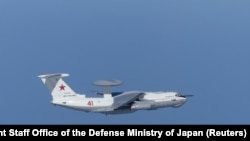On July 22, a joint air patrol mission including Chinese and Russian military aircraft were involved in an incident over the Sea of Japan. Two Russian Tu-95 strategic bombers and two Chinese H-6 strategic bombers were flying over the Sea of Japan, accompanied by early warning aircraft, a Russian A-50 and a Chinese KJ-2000, when South Korean Air Force jets intercepted them for allegedly violating Republic of Korea airspace near the disputed Dokdo (in Korean) or Takeshima (in Japanese) islands.
According to Seoul, the South Korean planes, including F-15 and F-16 fighter jets, fired 360 cannon rounds and ten flares at the A-50, which they identified as the plane that had committed the violation.
The Russian Defense Ministry denied such an incident had taken place, saying that the route was pre-planned and over neutral waters. They also denied that any rounds had been fired. While it is difficult to independently verify exactly what happened, the South Korean side would be unlikely to admit to firing warning shots, an arguably extreme response to such a violation, if their planes had not actually opened fire.
Japan claims the islands, which are physically occupied by South Korea, as its own, and lodged formal complaints against both Russia and South Korea over the incident. Japan’s Foreign Minister Taro Kono said that it was Japan’s responsibility to secure the airspace over the islands since Tokyo considers them a Japanese territory. However, according to the Japan Times, the Japanese Defense Force has no air defense identification zone over the islands, since they are “occupied” by the Republic of Korea.
To make matters ever more confusing, on June 24, South Korean presidential spokesman Yoon Do-Han claimed that a Russian military attaché in Seoul had apologized for the incident, blaming it on a “technical failure” and promising that they would take “necessary measures” to avoid such incidents in the future. However, that same day, Interfax reported that Russia’s military attaché in Seoul, Dmitry Bannikov, denied making such an apology.
With three sides disputing the details of the incident, it is hard to tell exactly what happened. There is strong evidence the South Korean fighters did open fire, given that Seoul officials reported that they had, as did Japan in its complaint against the Republic of Korea. It is unlikely that the South Korean pilots would have fired had they not strongly believed Korean airspace had been violated. However, the severity and duration of that incursion is unknown.
China has made no official statement in regards to the incident. However, the Xinhua agency reported on July 23 quoted Sergei Kobylash, commander of the Russian aerospace forces' long-range aviation as admitting the incident did take place, and saying the South Korean pilot’s actions were “unlawful and dangerous” and calling them an “aerial hooliganism.” Kobylash denied the incident involved a “warning fire” from the South Korean fighters.
In an analogous case from 2015, the Turkish Air Force shot down a Russian Su-24 fighter-bomber over Syria after it had allegedly violated Turkish airspace. While, contrary to Russian Defense Ministry claims that their plane hadn’t done so, data showed that it had indeed violated Turkish airspace, but only for 17 seconds. Turkish aircraft engaged and shot down the Russian fighter-bomber afterwards, while it was in Syrian airspace.





